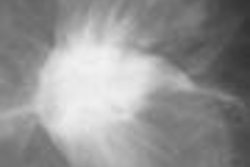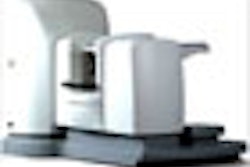CHICAGO - Breast ultrasound can detect mammographically occult early-stage cancer, but there is still a substantial risk of false positives (FP), according to initial results of the ACRIN 6666 trial presented Monday at the RSNA 2007 meeting.
Lead investigator Dr. Wendie Berg, Ph.D., discussed the results from the first round of screening in the American College of Radiology Imaging Network (ACRIN 6666) trial, which compared ultrasound screening plus mammography to mammographic screening alone in more than 2,800 women at high risk for breast cancer. The trial began in 2004.
"If we're looking at supplemental screening, there are three measures of efficacy that we need to consider: The yield for cancer detection rate should be high, over four per 1,000 women (screened). Cancers should be small and node-negative if we are going to improve outcomes for early detection. The interval cancers should be low, and the false-positive rate should be relatively low and well-tolerated by patients," Berg said.
Berg, who is a consultant for Naviscan PET Systems of San Diego, CA and for Siemens Medical Solutions of Malvern, PA, noted that these results are for the first round of prevalence screening. Annual screening for these patients is still ongoing, she said.
The total trial patient population consisted of 2,809 high-risk women with nonfatty breasts. They underwent mammography or physician-performed sonography in randomized order at 20 different U.S. sites. A different group of physicians interpreted the results. The reference standard was biopsy or one-year follow-up.
"For interpretation, we did use the expanded BI-RADS scores," Berg said. "We considered the tests negative if the assessment was (BI-RADS) category 1, 2, or 3 and positive if it was 4A, 4B, and 4C, or 5. We had no BI-RADS 0."
At the RSNA meeting, Berg shared results on 2,504 participants (4,525 breasts) with complete data. The mean age was 55 years, and the majority of these women (55%) had a personal history of breast cancer. Overall, 40 breasts in 39 patients were diagnosed as cancerous. A dozen cases were seen on ultrasound alone, another dozen on mammography, eight cases were seen on ultrasound and mammography, and eight on mammography alone.
The cancer yield for ultrasound alone was 4.2 per 1,000 versus eight per 1,000 for mammography alone. The cancer yield for ultrasound plus mammography was 12.4 per 1,000 women screened. This put the supplemental yield of the combined modalities at 4.4 per 1,000 women screening. The diagnostic accuracy for mammography and ultrasound was 93% compared with 79% for mammography alone.
With regard to the cancers seen on ultrasound alone, the majority (seven of 12) were intraductal carcinoma plus ductal carcinoma in situ (DCIS). The mean size of these cancers was 10 mm, and 90% were node-negative. Breast density did not affect the supplemental ultrasound yield.
In a subset of patients (1,586) who underwent full-field digital mammography (FFDM), four of 14 cancers were seen on ultrasound alone while three were seen on both modalities. There were five interval cancers, including one melanoma metastatic to axillary nodes.
"At this time, I think we can say with confidence that ultrasound screening does result in a significant cancer detection yield, in this series it was 4.2 cancers per 1,000 high-risk women screened. The vast majority of those cancers were small and node-negative," Berg said.
False positives
Results were not so encouraging when it came to the FP rate of ultrasound screening. Using the same patient data as described above, the ACRIN researchers found that 13% of the mammographic screening exams were recommended for something other than routine follow-up versus 28% of the ultrasound/mammography exams.
After combined ultrasound and mammography exams, 266 cases were referred for six-month follow-up, 206 of which were prompted by sonographic results. Additional imaging was recommended in 195 cases, and 14 of these were done because of ultrasound results. Finally, 241 cases were sent for biopsy, 199 of which were due to ultrasound imaging.
Of the 168 patients (6.7%) that actually underwent biopsy based on ultrasound results, 7.1% had proven cancer, 3.6% had atypical lesions, and 89% had benign results. Of the 46 patients who underwent biopsy based on mammographic results alone, 26% had cancer, 2% had atypical lesions, and 72% had benign results.
Among the 274 patients who were followed up at one year, only one proved to have a malignancy, which was a 4-mm invasive cancer that was seen on initial screening mammography, then followed with mammography and ultrasound.
Berg and colleagues found that the addition of ultrasound screening to mammography resulted in additional biopsies in 6.7% of the participants, of whom only 7.1% actually had cancer. Additional short-interval follow-up was deemed appropriate in another 8% based on sonographic results.
"At this point, if we are going to offer screening ultrasound, we need to make the woman aware of the substantial risk of false positives," Berg stated. "At this time, we can also say that risk exceeds the existing standards of mammography and MR. There may be a lower threshold (for biopsy recommendation) with ultrasound because it is easier to perform ultrasound-guided biopsy, but the false-positive rate is unequivocal. For some women, these risks outweigh the potential benefits."
Berg said that the ACRIN 6666 data would be analyzed for the cost-effectiveness of ultrasound screening. In addition, her group will look at the value of supplemental MRI after detailed ultrasound and mammography. Finally, annual incidence screening at 12 and 24 months will move forward. The latter may lead to a decrease in FP results, especially for noncancerous diseases such as fibrosis and ruptured cysts, as clinicians will have access to the first study for comparison.
By Shalmali Pal
AuntMinnie.com staff writer
November 26, 2007
Related Reading
US breast trial leaders aim to discuss ACRIN 6666 data at RSNA, October 8, 2007
Tumor type, breast profile determine value of mammo, US, and MR, January 6, 2005
Breast US readers need more practice with postop changes, December 22, 2004
Breast imagers fare better with hands-on approach to screening ultrasound, December 17, 2004
Copyright © 2007 AuntMinnie.com



















